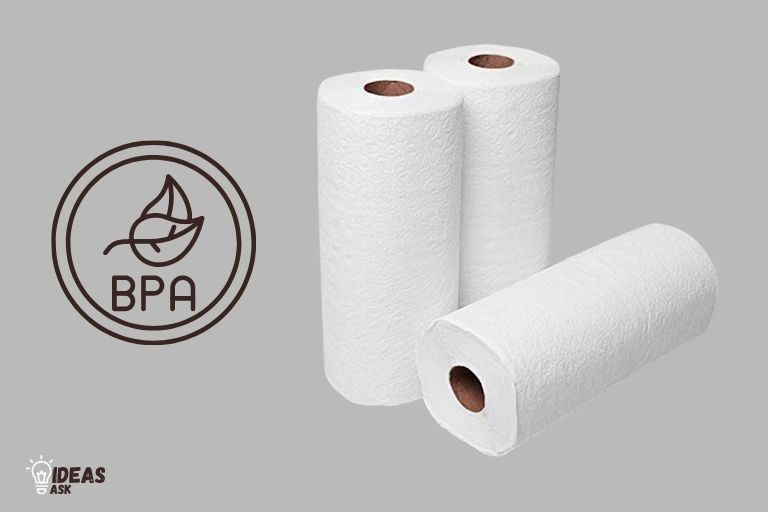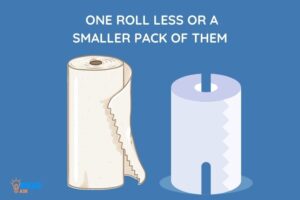Do Paper Towels Have Bpa? No!
No, paper towels do not typically contain BPA (Bisphenol A). The main source of BPA is through plastics and epoxy resins, which are not components of paper towels.
Bisphenol A (BPA) is a chemical that is often found in a variety of consumer products, such as plastic containers and thermal receipts.
However, paper towels are usually made from pulp, derived from wood or other plants, and don’t require the use of BPA for their production.
While the recycling process can potentially contaminate paper products with BPA, the levels found in recycled paper towels are minimal and not considered harmful.
While BPA is a common chemical in many consumer products, paper towels are not a significant source.
They are typically made from plant-derived pulp, without the need for BPA. Although there can be minimal contamination during the recycling process, the levels are not considered harmful.
It’s always a good idea to choose products from companies that are transparent about their manufacturing processes to ensure the safety and health of your home.
BPA Content in Different Brands of Paper Towels
| Brand | Contains BPA |
|---|---|
| Bounty | No |
| Brawny | No |
| Scott | No |
| Viva | No |
| Kirkland | No |
| Seventh Generation | No |
| Store Brand | Varies |
Key Takeaway

Five Facts About BPA in Paper Towels
Understanding Bpa And Its Impact On Human Health
Defining Bpa And Its Common Uses
Bisphenol a, known as bpa, is a chemical found in many plastic products and can liners. It is used in the manufacturing of polycarbonate plastics, which is clear and shatter-resistant.
You can also find it in items like compact discs, eyeglass lenses, and some food packaging materials.
Some of the common products that contain bpa include:
- Water bottles
- Food containers
- Receipt paper
- Dental sealants
- Baby bottles and sippy cups
The Link Between Bpa And Human Health
Over the years, the use of bpa has caused concern and controversy over its safety. Various scientific studies have discovered links between bpa exposure and potential health risks in humans.
The chemical can seep into food and drink, leading to ingestion into the body, where it mimics the effects of estrogen in the system.
Studies have found bpa exposure in humans can contribute to health issues including:
- Obesity
- Infertility
- Cardiovascular disease
- Developmental delays in children
- Diabetes
- Hypertension
Health Risks Associated With Exposure To Bpa
The harmful effects of bpa exposure are well known and established through scientific research. The chemical can have severe impacts on human health, especially if exposure is long-term.
Below are some of the potential risks of bpa exposure:
- Cancer
- Affects the proper functioning of the thyroid gland
- Neurological problems
- Fertility issues
- Depression
- Anxiety
- Asthma
Reducing or eliminating exposure to bpa is essential. Eating a diet rich in natural and organic foods can go a long way in reducing exposure.
Opting for products labeled as bpa-free can also help reduce exposure. It is vital to note that pregnant women and infants are the most vulnerable groups, and limiting their exposure to bpa is crucial for their overall health and well-being.
Examining The Composition Of Paper Towels
Paper towels are a household essential, used for cleaning up spills, wiping down surfaces, and even as an alternative to napkins.
But what are paper towels made of, and how are they processed? In this section, we’ll take a closer look at the composition of paper towels and the common chemicals used in their production.
What Are Paper Towels Made Of?
Paper towels are typically made from wood pulp, which is the primary ingredient. However, other materials may be added to enhance absorbency and strength.
These materials may include:
- Water: Used to hydrate the wood pulp and form a slurry.
- Bleach: Used to lighten the color of the paper towels.
- Optical brighteners: Used to enhance the whiteness of the towels.
- Synthetic polymers: Used to increase absorbency and strength.
How Are They Processed?
The production of paper towels typically involves the following steps:
- Wood pulp is mixed with water to form a slurry.
- The slurry is then pumped onto a moving screen, which helps to remove excess water and form the desired thickness.
- The paper is then pressed and dried.
- The paper may be subjected to additional processing steps to enhance its absorbency and strength.
Common Chemicals Used In The Production Of Paper Towels
As previously mentioned, bleach and optical brighteners are common chemicals used in the production of paper towels. In addition to these, synthetic polymers may also be added to enhance absorbency and strength.
Other chemicals that may be used include:
- Formaldehyde: Used as a bonding agent.
- Sodium hydroxide: Used to break down the wood fibers.
- Sodium borohydride: Used as a reducing agent to enhance the brightness of the paper.
- Sodium polyacrylate: Used to increase absorbency.
While these chemicals are generally considered safe in the quantities used in paper towels, some people may be sensitive to them.
It’s always a good idea to wash your hands after handling paper towels and to dispose of them properly.
Investigating Bpa In Paper Towels
Are you concerned about the safety of using paper towels due to the potential health risks of bisphenol a (bpa)? Bpa is a substance found in some household products, including certain types of plastic and cash register receipts.
We will investigate whether or not paper towels contain bpa, the content of bpa in different brands of paper towels, and the potential risks of exposure to bpa through the use of paper towels.
The Use Of Bpa In Paper Towels
Bpa is not intentionally added to paper towels during the manufacturing process. However, some paper products may contain traces of bpa due to contamination.
In the past, bpa was used in the manufacture of thermal cash register receipts and some paper products to make them more durable.
Fortunately, bpa has been eliminated from most thermal paper products, and only a small amount is used in a limited number of paper products, such as some recycled paper towels.
The Content Of Bpa In Different Brands Of Paper Towels
To determine the content of bpa in different brands of paper towels, several studies have been conducted.
The studies indicate that the content of bpa in paper towels varies from one brand to another, and many brands do not contain any detectable amount of bpa.
However, some recycled paper towels may contain bpa due to the use of recycled paper that may have been contaminated with bpa.
Potential Risk Of Exposure To Bpa Through Use Of Paper Towels
The potential risk of exposure to bpa through the use of paper towels is minimal. The risk of exposure is significantly lower than exposure from other sources, such as canned foods or plastic water bottles. According to the u. s.
food and drug administration (fda), the levels of bpa that can be ingested from paper products are low and do not pose a health risk to consumers.
However, if you are concerned about exposure to bpa, you can choose paper products that are labeled as bpa-free or made from virgin materials.Overall, the use of paper towels does not pose a significant risk of exposure to bpa.
However, if you are concerned about the potential risks of bpa exposure, you can take steps to reduce your exposure to bpa by choosing paper products that are labeled as bpa-free or made from virgin materials.
The Effects Of Bpa Exposure Through Paper Towels
Health Risks Associated With Bpa Exposure Via Paper Towels
Bisphenol a (bpa) is a chemical frequently used in the manufacturing of plastic products, and paper towels are no exception.
Bpa is an endocrine disruptor, which means it can affect the hormonal balance in the body leading to several health issues.
Here are some health risks associated with bpa exposure via paper towels:
- Increased risk of infertility and reproductive problems
- Developmental and behavioral issues in fetuses, infants, and children
- Higher risk of cancer and heart diseases
- Impaired immune function
The Impact Of Paper Towel Use On Children And Infants
Children and infants are particularly vulnerable to bpa exposure from paper towel use.
Babies use paper towels to clean their mouths and hands, and children use them to clean up after art projects and other messy activities.
Their prolonged exposure to bpa can cause significant hormonal disruption and developmental problems.
Here are some ways paper towel use affects children and infants:
- Bpa exposure can interfere with the development of reproductive organs leading to infertility
- Children exposed to bpa may have cognitive and behavioral issues like adhd and learning disabilities
- Bpa can affect the immune system of children, making them more susceptible to infections and allergies
- It can also lead to early puberty in girls
Alternatives To Paper Towels That Are Free Of Bpa
If you’re concerned about the health risks associated with bpa exposure through paper towels, there are several alternatives you can use that are free of bpa.
Some of these include:
- Cloth towels: Use washable and reusable cloth towels for cleaning and wiping surfaces instead of paper towels.
- Bamboo towels: Bamboo towels are an eco-friendly alternative to paper towels and are free of bpa.
- Natural sponges: Use natural sponges made from renewable materials like cellulose or coconut fibers.
- Air-drying: Use air-drying techniques like shaking off excess water to eliminate the need for paper towels.
By switching to these alternatives, you can reduce your exposure to bpa and minimize the health risks associated with its use.
FAQ On BPA in Paper Towels
Are Paper Towels Safe To Use?
Yes, paper towels are safe to use for cleaning purposes as they do not pose any health hazard.
Does Bpa In Paper Towels Affect Health?
No, bpa in paper towels does not affect health as it is present in negligible amounts.
Are All Paper Towels Bpa-Free?
No, not all paper towels are bpa-free. However, most manufacturers do not use bpa in their paper towels.
Is There Any Alternative To Paper Towels?
Yes, there are eco-friendly alternatives to paper towels such as cloth towels, bamboo towels, and reusable cleaning wipes.
Conclusion
Overall, it is essential to prioritize our health and safety by being aware of the chemicals present in everyday products. While paper towels are convenient, they may have harmful chemicals such as bpa that pose health risks.
Consumers should consider using bpa-free paper towels or alternatives like cloth towels and rags. It is worth the investment to maintain a healthy home environment and prevent potential long-term health effects.
Considering that paper towels are single-use products, switching to a reusable option like cloth towels can also be cost-effective in the long run.
Taking small steps towards minimizing exposure to harmful chemicals can make a big difference in our overall physical well-being. So let’s be mindful of what we bring into our homes and take the necessary steps to protect our health.





